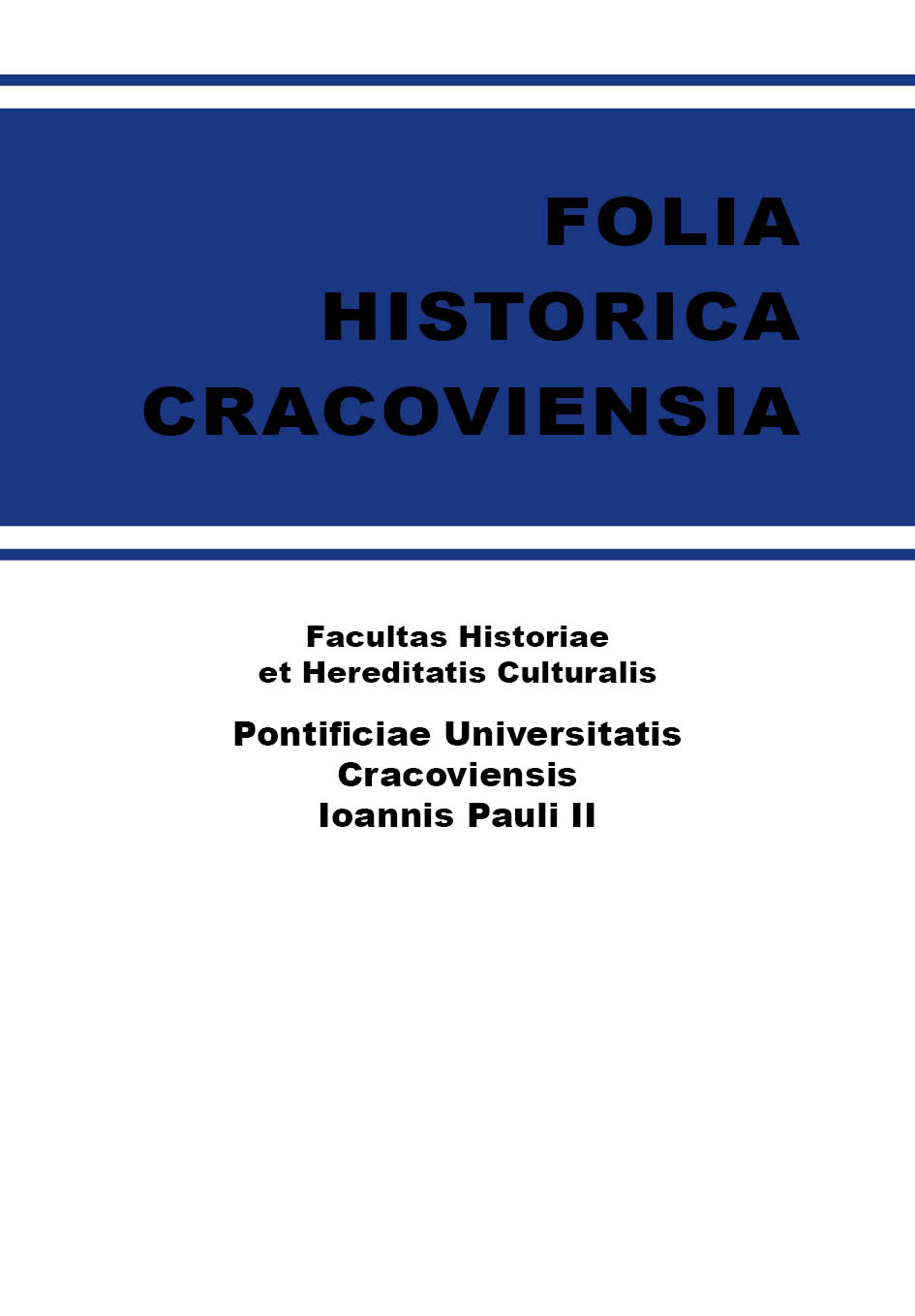Five Martyr Brothers. First Polish hermits and their worship
DOI:
https://doi.org/10.15633/fhc.2071Keywords:
Five Martyr Brothers, hermits, worship, martyrdom, inscription, bishop Jan LubrańskiAbstract
Brothers Benedict and John, students of Romuald, came to Poland at the invitation of Otto III to convert pagans. Soon the Italian hermits were joined by Polish bro-thers Isaac and Matthew, who helped them in learning the Slavic language. The hermits, as well as Christinus, well killed in 1003 by thugs who wanted to steal money given by Duke Boleslav to an expedition to Rome, which was aimed at obtaining papal consent for conducting missionary work. Although the hermits died as victims of a robbery, killed by fellow Christians, the pope canonized them as martyrs. Their lives are relatively well-documented: the earliest and the most credible story of the five brothers by Bruno of Querfurt was written as early as five years after their death, although remained unknown until 1883. Another early account is the life of St. Romuald by Piotr Damiani of 1041. The martyrs have been also associated with yet another mysterious work – a gravestone unearthed in 1959 at the external wall of the north Roman apse of the Gniezno Cathedral, considered by most researchers the oldest epigraphic item on the Polish soil. However, the identification of the warriors mentioned in the inscription with 11th century martyrs raises many doubts. The article discusses the above matters, as well as the subject of the development of the worship of the martyr brothers.
References
Archiwum Prowincji Polskiej Bernardynów w Krakowie, sygn. S-ka 1, D. Elewski, Chronologia konwentu kazimierskiego.
Baroniusz M., Vitae, gesta et miracula sanctorum quinque fratrum Polonorum eremitarum casimieriensium, Cracoviae 1610.
Brochwicz Z., Badania wczesnośredniowiecznych zapraw budowlanych integralną częścią badań archeologicznych, „Materiały Zachodniopomorskie” 21 (1975), s. 95–244.
Chodyła Z., Czasy nowożytne (1504–1793), [w:] Dzieje Kazimierza Biskupiego, t. 1, red. Z. Chodyła, Kazimierz Biskupi–Konin 2001
Ciechanowski K., Epigrafia romańska i wczesnogotycka w Polsce, Wrocław 1965.
Die Chronik der Böhmen des Cosmas von Prag, Hrsg. B. Bretholz, Berlin 1955, s. 89–90 (Monumenta Germaniae Historica. Scriptores Rerum Germanicarum. Nova Series, 2).
Dusza T., Pięciu Braci – kwestie kontrowersyjne, „Nasza Przeszłość” 68 (1987), s. 30–39.
Górska-Gołaska K., Kult Pięciu Braci Męczenników w Kazimierzu Biskupim i rozwój towarzyszącej im legendy, „Roczniki Historyczne” 61 (1995), s. 111–120.
Janiak T., Problematyka wczesnych faz kościoła katedralnego w Gnieźnie, [w:] Początki architektury monumentalnej w Polsce, red. T. Janiak, D. Stryniak, Gniezno 2004.
Jaroszewicz F., Matka Świętych Polska albo żywoty świętych, błogosławionych, wielebnych, świątobliwych, pobożnych Polaków i Polek, Kraków 1767.
Jurkowlaniec G., Kult obrazów a kult świętych w nowożytnym Krakowie, „Barok” 11 (2004) nr 2, s. 69–87.
Joannis Dlugossii Annales seu Cronicae incliti Regni Poloniae, I, Varsaviae 1964.
Maciej z Miechowa, Chronica Polonorum, libri 2, Cracoviae 1521.
Michałowski R., Translacja Pięciu Braci Polskich do Gniezna. Przyczynek do dziejów kultu relikwii w Polsce wczesnośredniowiecznej, [w:] Peregrinationes. Pielgrzymki w kulturze dawnej Europy, red. H. Manikowska, H. Zaremska, Warszawa 1995.
Mikołajczyk G., Początki Gniezna, t. 3, Warszawa–Poznań 1973.
Mikołajczyk G., Bolz B., Gnieźnieńska inskrypcja nagrobna z początku XI stulecia, „Symbolae Philologorum Posnaniensium” 4 (1979), s. 139–166.
Mitkowski J., Pięciu Braci Męczenników, [w:] Hagiografia polska. Słownik bio-bibliograficzny, t. 2, red. R. Gustaw, Poznań 1971.
Nizio K., Nieznany przekaz historii Pięciu Braci Męczenników w rękopisie BK 1624, „Pamiętnik Biblioteki Kórnickiej” 23 (1993), s. 163–180.
Pleszczyński A., Bolesław Chrobry konfratrem eremitów św. Romualda w Międzyrzeczu, „Kwartalnik Historyczny” 103 (1996) z. 1, s. 3–22.
Płóciennik T., Kilka uwag na temat inskrypcji gnieźnieńskiej „OSSA TRIUM…”, [w:] Architektura romańska w Polsce. Nowe odkrycia i interpretacje, red. T. Janiak, Gniezno 2009.
Pruszcz P.H., Forteca Duchowna Królestwa Polskiego, Kraków 1662.
Szczygielski S., Aquila Polono Benedictina, Cracoviae 1663.
Świechowski Z., Architektura romańska w Polsce, Warszawa 2000.
Witkowska A., Tradycje kultu Pięciu Braci Męczenników, [w:] A. Witkowska, Sancti, miracula, peregrinationes, Lublin 2009.
Witkowski R., Żywot Pięciu Braci Męczenników jako źródło do dziejów monastycyzmu. Na marginesie książki Giuseppe Vedovato, [w:] Męczennicy z Międzyrzecza 1003–2003, red. R. Tomczak, Paradyż 2003.
Downloads
Published
Issue
Section
License
Authors who publish with this journal agree to the following terms:
- Authors retain the copyright and full publishing rights without restrictions, and grant the journal right of first publication with the work simultaneously licensed under a Creative Commons Attribution 4.0 International License that allows others to share the work with an acknowledgement of the work's authorship and initial publication in this journal.
- Authors are able to enter into separate, additional contractual arrangements for the non-exclusive distribution of the journal's published version of the work (e.g., post it to an institutional repository or publish it in a book), with an acknowledgement of its initial publication in this journal.
- Authors are permitted and encouraged to post their work online (e.g., in institutional repositories or on their website) prior to and during the submission process, as it can lead to productive exchanges, as well as earlier and greater citation of published work (See The Effect of Open Access).

